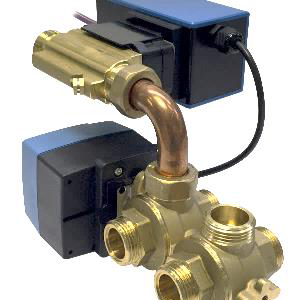
The Smart Control Valve
Say goodbye to all the cables for controls and say hello to an integrated motorized valve complete with regulator, air temperature control, and water flow sensor.
HVAC control systems traditionally come with a room temperature sensor, a local controller and a motorized equipment. For example, with hydraulic terminals, the motorized equipment to be controlled is a 2-, 3- or 6-way valve.
In today’s buildings, the system in vogue is the reversible radiant ceiling, good for both heating and cooling. To regulate room temperatures per zone or per premises, a 6-way motorized control valve is connected to both cold-water and hot-water networks.
Today, BELPARTS offers a new kind of control unit solution: one that’s pre-cabled and includes a room temperature controller coupled to an ambient temperature sensor, water flow rate sensor and a motorized valve.
Find out more
- How it works
Based on the room temperature’s feedback, the controller sends a set value signal between 0-10 volts to the motorized valve. The rate at which a valve opens is factory-calibrated according to a design maximum flow requested by the installer to BELPARTS. The position of the servo motor is then monitored on the basis of the actual measured flow, and the set point sent by the controller.
It’s also possible to adjust settings on-site, thanks to an LCD screen (as an option) that provides the flow-rate. This valve is equipped with a communication card that allows users to adjust or modify the set point through the BMS or to simultaneously force open all the valves of a specific site, handy for network flushing and rinsing operations.
In the new version, announced sometime this year, the LCD screen will be replaced by a Bluetooth card hooked up to an Android or iOS application; adjusting valve settings will then be possible without opening the false ceilings. And the “smart” part of the device (controls) will be integrated in the same carter as that of the servo motor.
- Advantages
The main advantage over standard set-ups? You no longer need to install separate parts such as regulator sets, power, protection, DIN rails, cables between the regulator and the valve in the suspended ceilings. Quality checks for the cablings are not necessary any more. The only cable needed goes from the Temperature sensor to its potentiometer +3°/-3°. And finally, the valve commissioning is much faster and safer, thanks to integrated water flow-rate readings.
Cegelec Belgium has done a techno-economic analysis of BELPARTS’ solution versus classic ones. BELPARTS’ 6-way valve is more expensive than classic valves because it includes smart technology and measuring features. But comprehensive assessments integrating time saved on installation and commissioning show BELPARTS’ solution is more advantageous.
- Applications
This self-regulating valve includes its own room temperature regulator, proving its usefulness in operations where the monitoring of other equipment (shades, lightings, air valves) are done by different systems. In case a multi-purpose regulator is specified, it’s possible to use BELPARTS’ valve without its room temperature regulator, in which case the BELPARTS valve functions like similar products on the market today (BELIMO, for example).
Did you like the article ?



